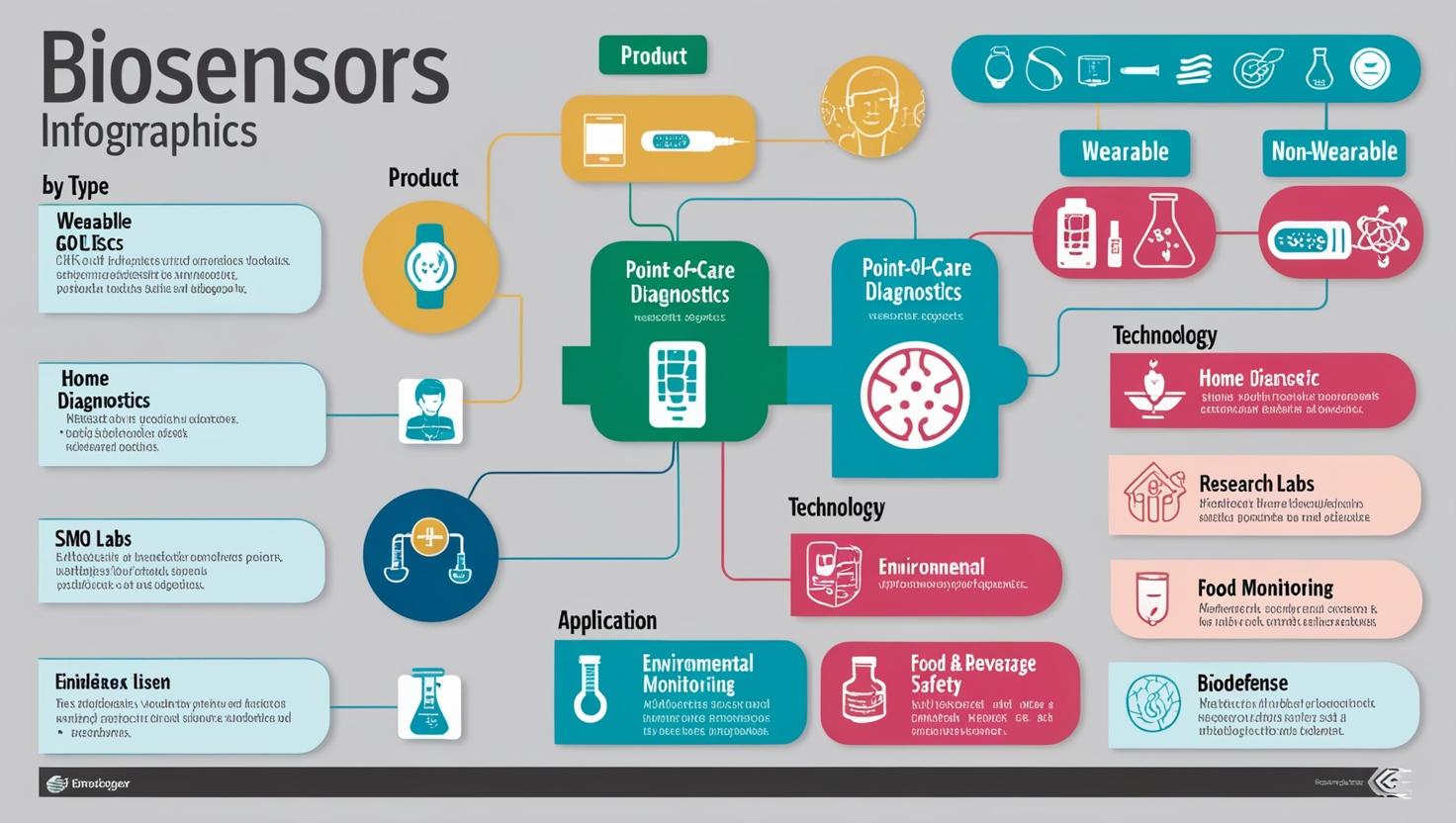The biosensors industry is undergoing rapid expansion, driven by the growing demand for real-time health monitoring, wearable technology, and point-of-care diagnostics. As healthcare systems shift toward preventive care, personalized treatment, and decentralized testing, biosensors are emerging as essential tools for data-driven decision-making and patient empowerment. With applications spanning healthcare, fitness, diagnostics, and even environmental monitoring, the biosensors industry is positioned at the forefront of innovation.
The Role of Biosensors in Modern Healthcare
Biosensors are analytical devices that convert biological responses into measurable signals. At their core, they integrate a biological recognition element (like enzymes, antibodies, or nucleic acids) with a transducer that converts the biological reaction into an electrical or optical signal. This seamless interaction allows for accurate, real-time analysis of biomarkers, offering critical insights into physiological and pathological conditions.
In the context of healthcare, the biosensors industry plays a pivotal role in delivering non-invasive, rapid, and user-friendly diagnostics. This is particularly relevant as the global health landscape faces challenges such as aging populations, chronic diseases, and the need for remote healthcare access.
Wearables: A Major Driver of Growth in the Biosensors Industry
One of the most dynamic segments within the biosensors industry is wearable biosensors. Devices like smartwatches, fitness trackers, and continuous glucose monitors have transitioned from lifestyle gadgets to medically valuable tools.
Modern wearable biosensors can continuously monitor:
-
Heart rate and rhythm
-
Glucose levels for diabetic patients
-
Blood oxygen saturation (SpO2)
-
Electrodermal activity and temperature
-
Sleep patterns and respiratory rate
Download PDF Brochure @ https://www.marketsandmarkets.com/pdfdownloadNew.asp?id=798

These data points, when integrated with cloud platforms and AI algorithms, enable real-time health insights and predictive analytics. As consumers become more health-conscious and tech-savvy, demand for wearable biosensor devices continues to grow. This surge has opened up new opportunities for innovation within the biosensors industry, particularly in miniaturization, wireless connectivity, and energy-efficient designs.
Point-of-Care Testing: Speed Meets Accessibility
Another critical area fueling the growth of the biosensors industry is point-of-care testing (POCT). These biosensor-based devices allow for rapid diagnostic testing outside of traditional laboratories—whether at home, in pharmacies, or at remote clinics.
The COVID-19 pandemic significantly accelerated the development and adoption of POCT devices, highlighting the need for fast, accurate, and decentralized diagnostics. Biosensors were central to enabling lateral flow assays, antigen tests, and molecular diagnostics that could be administered and interpreted without specialized training.
Beyond infectious diseases, point-of-care biosensors are being developed for:
-
Cardiac biomarkers (e.g., troponin)
-
Cancer detection
-
Hormonal and fertility testing
-
Renal and liver function markers
These advancements not only reduce diagnostic delays but also empower clinicians and patients to make informed decisions in real-time, especially in low-resource or urgent settings.
Technological Innovations Propelling the Biosensors Industry Forward
The growth of the biosensors industry is closely tied to ongoing innovations in nanotechnology, microfluidics, wireless communication, and artificial intelligence.
-
Nanomaterials like graphene and carbon nanotubes are enhancing sensitivity and reducing detection limits.
-
Lab-on-a-chip designs are enabling compact, integrated biosensing platforms.
-
Bluetooth and IoT integration allow for continuous remote monitoring and data sharing with healthcare providers.
-
AI and machine learning algorithms are being applied to biosensor data to detect early disease signals, forecast health trends, and recommend personalized interventions.
These technological advancements are helping the biosensors industry meet the evolving needs of personalized medicine and remote patient care.
Market Outlook and Future Potential
The global biosensors industry is projected to grow from USD 34.51 billion in 2025 to USD 54.37 billion by 2030, at a CAGR of 9.5% Key factors contributing to this growth include:
-
Rising prevalence of chronic conditions such as diabetes and cardiovascular disease
-
Growing adoption of home healthcare and telemedicine
-
Increasing investments in healthcare R&D and diagnostics innovation
-
Supportive regulatory policies for wearable medical devices and POCT solutions
Furthermore, emerging applications in sports science, military readiness, environmental monitoring, and food safety are expanding the biosensors industry beyond its traditional boundaries.
Challenges and Opportunities
While the biosensors industry is thriving, it also faces challenges related to:
-
Data privacy and cybersecurity for connected devices
-
Sensor calibration and reliability in varied environments
-
Regulatory approval hurdles for clinical-grade biosensors
-
High development costs for novel sensing materials and platforms
However, these challenges are also catalysts for innovation. Companies that can address these barriers with scalable, user-friendly, and interoperable solutions will be well-positioned to lead in this rapidly evolving sector.
The biosensors industry is witnessing a powerful surge as the lines between healthcare, technology, and consumer electronics continue to blur. With the expansion of wearables and point-of-care testing, biosensors are enabling a new era of proactive, personalized, and connected health monitoring. As innovation accelerates and adoption deepens across industries, biosensors will remain at the core of next-generation diagnostics and preventive care.
